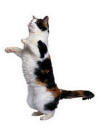What is
the Invisible Cat?
(A = It's a strategy)
Cats who are adored by their
owners, quickly find out how
to get what they want. They
they begin to do these
things to get whatever it is
they want at the time.
When they become
invisible, they quickly
find out how to deliver what
the owner wants, so as
to become visible again.
The "Invisible Cat" is a
behavioral modification
technique recommended for
some cats. The goal of
this technique is to avoid
the need for punishment by
making human attention
more valuable. If the
cat can get human attention
at will, that attention
becomes less valuable, and
therefore less of a reward.
The Invisible Cat is also
useful during some behavior
modification strategies as a
buffer between the OLD way
things were, and the NEW way
things are going to be.
Essentially, the
Invisible Cat means that for
1 week intervals, (until the
cat can pass the test below)
everyone in the home
pretends the cat is
invisible, unless it is
doing "work." (work is
explained below)
Exactly what
do I do?
(A = It's what you don't
do that counts)
During this period,
unless the cat is working,
the owner must act as if
the cat does not exist.
Pretend the cat is
invisible.
This means:
- do not greet the cat
at the door (just walk
on by if the cat cannot
SIT to earn a greeting)
- do not pet the cat
when it lays its head in
your lap - or any time
it "asks"
do not play with the
cat when it brings you a
toy
do not make eye
contact with the cat
(unless the cat is
working)
do not speak to the
cat (except to give a
command)
do not respond to
any request for
attention or interaction
do not punish the
cat (if necessary put
the cat in time-out)
provide food and
water without comment at
the normal times
When can
I give attention during this
period?
 (A = when the cat is working
for praise)
(A = when the cat is working
for praise)
You can give the cat
attention only WHILE the cat
is working. A cat
"works" when he or she is
doing something you asked
the cat to do.
You can talk to,
reassure, and pet the cat
while it is actually…
- doing a Sit-Stay or
Down-Stay you requested
- in the act of
responding to any
command you give
- resting quietly in
the pet's portable
kennel or any other
place you designate
- chewing on an
approved chew
- waiting to go
through any door
How does
the cat become "visible"
again?
(A = By passing a test)
The cat "earns"
becoming visible again, by
demonstrating that it will
work for praise in a
novel situation. Here
is the test:
Take the cat to a safe
area where you do not
commonly give commands.
A specific area in the back
yard or an unused tennis
court works nicely.
Without any food treats, ask
the cat to perform every
command it knows, but at
least Come and Sit (Down and
Stay optional.) The
only reward is your praise,
and the cat must happily
respond within 2 seconds of
each command. If this
test is passed, then the cat
becomes visible for a month.
If the cat does not value
praise enough to do these
simple jobs, (during any
test) he or she returns to 1
additional week of being
"invisible" and learning
that human praise and
attention are very valuable
commodities.
It is
too difficult - I can't
ignore my cat!
This technique is often
difficult on owners but is a
very important step in the
behavior modification
recommended for your cat.
Many cats for a short period
do get worse before they get
better. When he or she
gradually realizes that
their happiness is "earned"
it will get easier. It
is in our nature to
occasionally make mistakes
and be frustrated. Be
strong and stick with the
program!